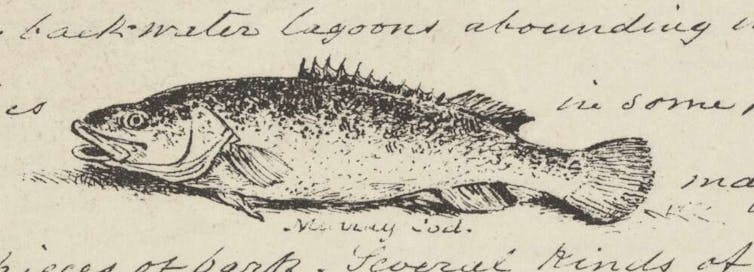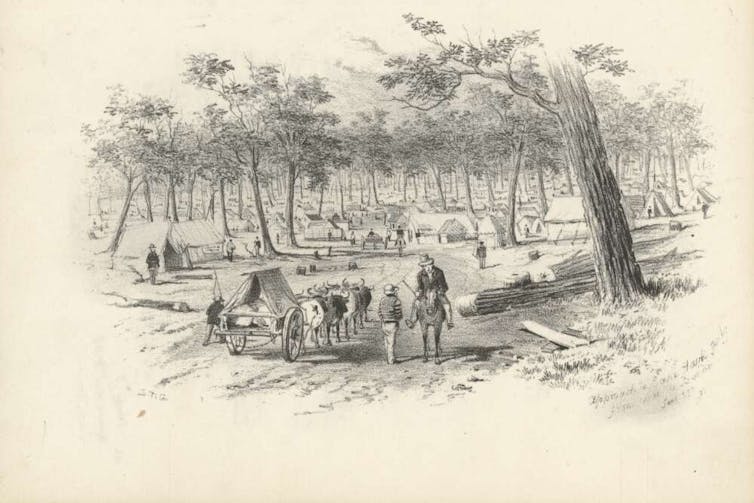Source: The Conversation (Au and NZ) – By Paul Humphries, Associate professor in ecology, Charles Sturt University
In this edited book extract, Paul Humphries describes how a proposal to feed hungry miners on Victoria’s goldfields led to a Murray cod fishery – and the collapse of cod populations, the effects of which are still with us today.
Within months of the discovery of gold in 1851 in the previously sleepy little hamlets of Ballarat, Castlemaine and Bendigo, the Victorian goldfields were out-performing those in California. By 1852, ships hailing from Melbourne were sailing up the River Thames, carrying up to 10 tonnes of gold to London.
Convicts, previously reluctant to be sent out to the colony, now begged for transportation. Immigrants from England, Europe, The United States and China arrived in Melbourne in their hundreds each day. Along with the diggers came those that supplied their wants and needs: store keepers, butchers, bakers, grocers, barbers, printers and other tradespeople. Gold, population and trade boomed.
By 1854, the Victorian population had surpassed that of New South Wales, but the amount of gold extracted, although still substantial, was half it was two years previously. Discontent increased. There were violent clashes between soldiers, police and diggers, which culminated in a full-on battle on 3 December 1854 on Bakery Hill: the Eureka uprising.
Some canny miners who saw the boom was fast fading had an eye out for business opportunities. There was another untapped, seemingly limitless resource – another type of “gold” – waiting within coo-ee of the goldfields for the right person to come along and extract it. Not from earth. From water. The cod rush was about to start.
George French Angas, 1877
“We cannot exhaust the fish”
In the 19th century, there was by all accounts an abundance of large Murray cod, some reportedly 1.8 metres-long and weighing perhaps 80 kilograms. These long-lived predators cruised around the main channels of rivers, ate crayfish, mussels, fish and even ducks and mice when they could get them. For hungry gold miners, they must have seemed like a godsend.
In January 1855, an article in The Argus by an unnamed correspondent recorded that a semi-commercial fishery had begun in the Murray, supplying gold miners in Bendigo with fresh fish:
“The Murray abounds in splendid fish of the cod and bream species, varying in weight from an ounce to a hundred weight each,” they wrote.
The article recognised the demand for food from hungry gold miners, along with a supply of fish; the former seemingly insatiable and the latter apparently inexhaustible.

Samuel Thomas Gill
“We have a river unequalled in the colony in its magnitude. It is rich in delicious fish […] with which we intend at no distant period to cram the stomach of the rebellious digger of the Bendigo,” the correspondent wrote two months later.
By May 29th, the correspondent proposed exchanging the “superabundant” nuggets of the diggers with that of the “superfluous luxuries” in the Murray. A transparent pitch for distributing the wealth north of the goldfields. But they weren’t finished.
On 22 June 1855 in The Argus, the unnamed journalist wrote a lengthy proposal and presented a detailed business case – including estimates of outlays, profits and even methods (netting, hook and line, spearing) for catching fish that had been used by local Aboriginal peoples for thousands of years – for a commercial fishery in the Murray, supplying Bendigo.
Soon, a disillusioned miner with ambition recognised the opportunity. At the age of 27, Massachusetts-born Joseph Waldo Rice established the Lake Moira Fishing Company in mid–1855 with five others. Soon, that became the Murray Fishing Company or Murray River Fishing Company.
“We cannot exhaust [the fish],” suggested the Argus journalist, and ten times as many as they proposed could be harvested would not even deplete a small section of river.
The correspondent was grossly mistaken.
Boomtime and collapse
In the early days, a dozen or so men fished Moira Lake and the Murray and Edward rivers nearby, transporting a few baskets of fish to Bendigo by Cobb and Co. coach.
But within a few decades, hundreds of fishermen plied their trade from Albury to Lake Alexandrina with many thousands of fish transported to Melbourne, Sydney and Adelaide markets by railway each year.
Intensive fishing, questionable practices such as taking fish during the spawning season, a lack of regulation and the later rise of recreational fishing exhausted the supposedly inexhaustible resource.
Fish stocks fluctuated over time as fishing effort rose and fell, but catches hit rock-bottom in the early 1960s and never recovered. By then, many commercial fishers had already left the industry or retired.
It was only in the early 2000s that the unprofitable fishery was finally banned in all states of the Murray-Darling Basin.
Commercial fishing was largely responsible for the decline in Murray cod stocks over many decades. But the decline was hastened by dispossession of Aboriginal peoples, habitat destruction, the construction of dams and barriers, changes to river flows, the introduction of alien fishes and declining water quality.
And the decline in Murray cod numbers would itself have had far-reaching impacts on river food webs.
The legacy of the commercial fishery is still with us today, as is the sludge still being flushed into our rivers because of gold dredging.
Will the cod ever recover?
Despite widespread stocking campaigns and tight fishing regulations, Murray cod stocks were still “depleted” in the ACT and in South Australia as of 2020, and “undefined” in New South Wales and Queensland due to a lack of data. Only in Victoria were they considered “recovering”.
Across all jurisdictions, stocks are much lower than prior to European colonisation. Recovery of Murray cod stocks to pre-European levels is probably unrealistic and the recovery will be slow. But there is reason to be cautiously optimistic.
Scores of First Nations people, recreational angling and community groups, conservationists, and natural resource scientists and managers have worked hard to understand more about what makes this wonderful species tick. Many have put in place strategies to help ensure the Murray cod and many other native freshwater fish have a future.
There was a public outcry following recent mass fish kills, such as those in the Lower Darling–Baaka in 2018–19 and again in 2023. If this response is anything to go by, people care deeply about our rivers and the fish living in them.
While a commercial fishery in the Murray and its tributaries was probably inevitable following settlement, the Victorian goldrush provided the catalyst for its real beginnings and drove its early development.
The nameless Argus correspondent who started the cod rush would have never dreamt that their descendants would still be living with the consequences 170 years later.
This is an edited extract from The Life and Times of the Murray Cod, CSIRO Publishing, 2023.
![]()
Paul Humphries has in the past received funding from the Murray-Darling Basin Authority’s Native Fish Strategy.
– ref. Hungry gold miners created Victoria’s Murray cod fisheries – and we’re still dealing with the consequences – https://theconversation.com/hungry-gold-miners-created-victorias-murray-cod-fisheries-and-were-still-dealing-with-the-consequences-206768








